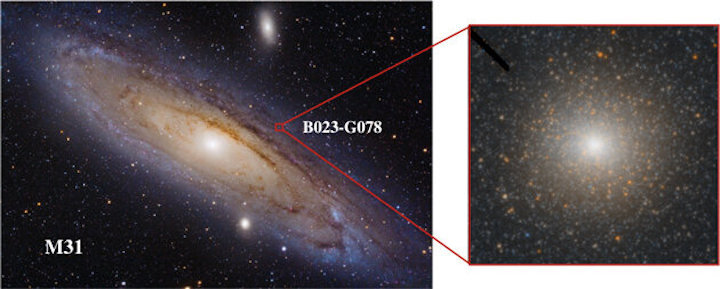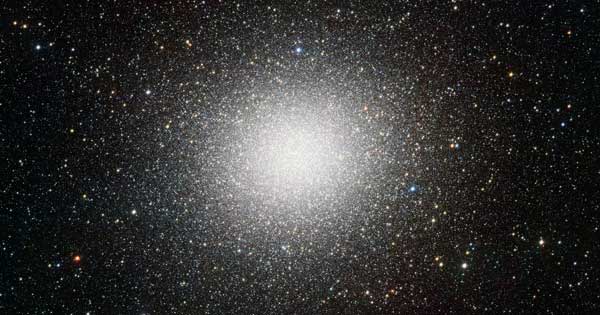29.01.2022
New observations suggest a black hole 100,000 times the mass of the Sun lurks in the center of a globular cluster of the Andromeda Galaxy.

The left panel shows a wide-field image of the Andromeda Galaxy (M31); the red box and inset show the location and image, respectively, of the globular cluster B023-G78, where an intermediate-mass black hole might lurk.
Iván Éder / HST ACS / HRC
Astronomers may have discovered an intermediate-mass black hole in the Andromeda galaxy. The find could ultimately help scientists better understand the growth of black holes in the universe.
Intermediate-mass black holes (IMBHs) fill the gap between low-mass stellar black holes — the remains of giant stars that went supernova — and the supermassive beasts that lurk in the cores of most galaxies. Surprisingly, very few mid-weight black holes have been identified so far. One of the most convincing candidates is HLX-1, an off-center X-ray source in the remote galaxy ESO 243-29, at a distance of 290 million light-years.
Now, a team led by Renuka Pechetti (Liverpool John Moores University, UK) claims to have found of a 100,000-solar-mass black hole in our nearest galactic neighbor, just 2 million light-years away. Like HLX-1, it’s not located in the galaxy’s center, but in one of Andromeda’s massive globular clusters, known as B023-G078.
Analyzing Hubble Space Telescope observations and high-resolution spectroscopic measurements from the 8.1-meter Gemini North Telescope at Mauna Kea, Hawai’i, the team mapped out the distribution of light, stellar velocities, and chemical composition in the giant cluster, which weighs in at some 6.2 million solar masses.
The steep rise of velocities toward the cluster core indicates the presence of a huge concentration of mass at the very center, the researchers write in a paper to be published in The Astrophysical Journal. What’s more, the cluster’s morphology and the observed spread in stellar composition suggest that B023-G078 isn’t a regular globular cluster. Instead, the astronomers argue, it’s probably the nucleus of a dwarf galaxy that ventured too close to Andromeda and lost most of its stars through a process known as tidal stripping.
Since dwarf galaxies are expected to harbor massive black holes at their cores, Pechetti and her colleagues argue that the mass concentration at the center of B023-G078 is most likely a 100,000-solar-mass black hole.

NASA / JPL-Caltech
According to Ryan Hickox (Dartmouth College, New Hampshire), who was not involved in the study, “The estimated black hole mass in this system is a bit smaller than you might expect from the estimated mass of the progenitor galaxy, [but] there is a fairly wide range of black hole masses for any given galaxy mass, especially in these small systems. So the estimated mass seems plausible.”
“This is a solid and impressive piece of work,” comments black hole researcher Peter Jonker (Radboud University, The Netherlands). “It will certainly add to the growing evidence for the existence of IMBHs, although it isn’t yet the long-sought irrefutable proof.” Indeed, the researchers admit that they cannot definitely rule out a more extended population of stellar-mass black holes as the cause of the observed velocity distribution.
Incidentally, the same is true for the candidate IMBH in the large globular cluster Omega Centauri in our own Milky Way galaxy. Like B023-G078, Omega Centauri is probably the stripped remains of a dwarf galaxy, and in 2008 astronomers claimed the presence of a 40,000-solar-mass black hole in its core. These results were later disputed, but according to Jonker, debate is still heated about whether Omega Centauri hosts a smaller 1,000-solar-mass black hole or a population of stellar black holes and neutron stars.

ESO / INAF-VST / OmegaCAM; Acknowledgement: A. Grado, L. Limatola / INAF-Capodimonte Observatory
As for the new candidate in the Andromeda Galaxy, Hickox looks forward to future spectroscopic observations with higher angular resolution, which “would be able to produce an even more accurate picture of the motions of stars in this system and could definitively say that this object is a single intermediate-mass black hole, rather than a collection of lower-mass black holes.”
Indisputable evidence for the existence of mid-weight black holes would lend credence to the theory that supermassive black holes grew through a process of hierarchical merging, starting from much smaller seeds. “If supermassive black holes form through the merger of smaller ones, then we should see many of these IMBHs,” says Karl Gebhardt (University of Texas, Austin). “They are just really hard to find.”
Especially revealing would be the detection of much smaller IMBHs of around 1,000 solar masses in “normal” globular clusters, says Heino Falcke (Radboud University). “They would need to have formed in a different way [than supermassive black holes]. They cannot grow much by accreting gas. Hence, that could maybe give us an idea where the early seeds of giant black holes came from.”
In addition, says Jonker, there are all kinds of ideas on how IMBHs can easily produce powerful jets, boost the emission of gamma rays through the annihilation of dark matter, and accelerate cosmic ray particles to extreme energies. “If they exist, they might solve a lot of problems.”
Quelle: Sky&Telescope
